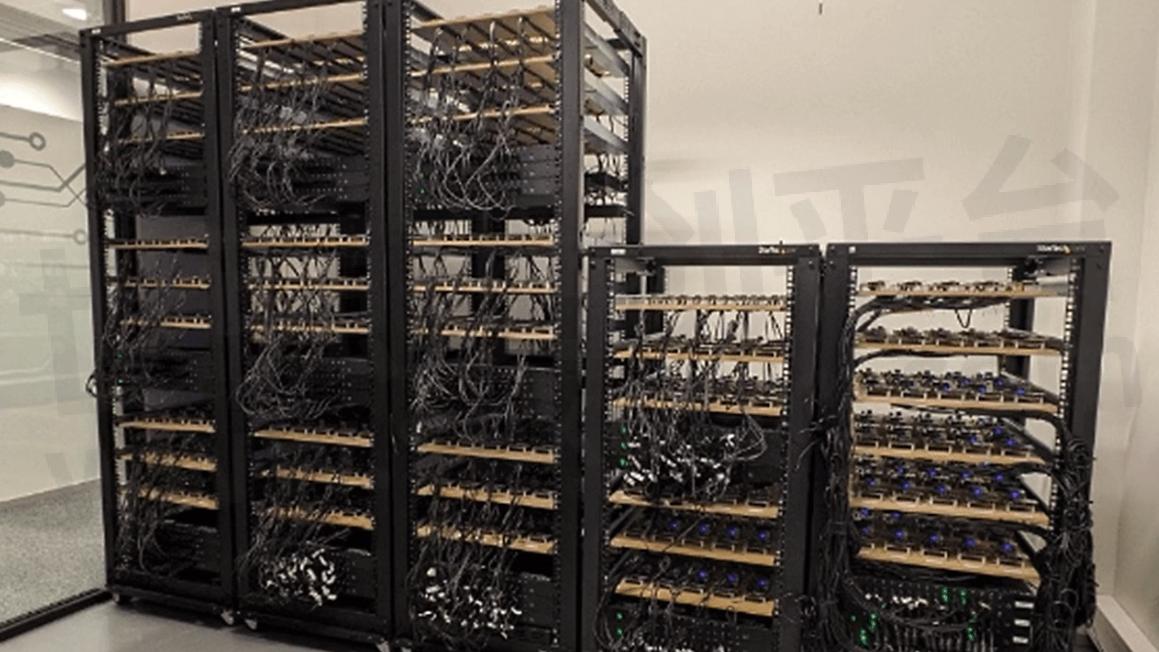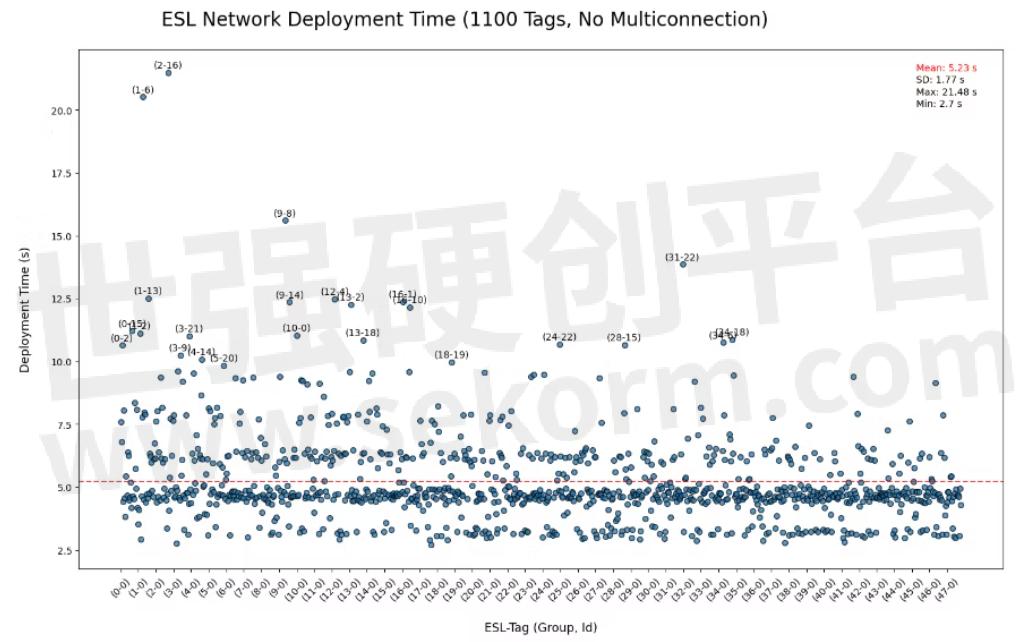Bluetooth PAwR in a Large-Scale Test Network


In the ever-evolving, dynamic landscape of Bluetooth-connected smart devices, efficient interconnection and reliable communication is crucial for successful product performance. With a growing demand for insightful and diverse data, wireless networks are growing larger. For Bluetooth Low Energy (LE), the growing need for large-scale networks with the capacity for thousands of nodes has remained unfulfilled as connection-based communication supports too few connections and connection-less communication has remained unidirectional. Furthermore, connection-based communication requires continuous dedicated airtime and memory, which puts considerable strain on the available energy resources. Real-time applications such as industrial automation and asset tracking also suffer from unreliable synchronization leading to latency issues. As these technologies have not been suitable for large-scale centralized networks, a new system had to be developed.
Enter Periodic Advertising with Responses (PAwR)
In version 5.4 of the Bluetooth Core Specification released in January 2023, a new feature called PAwR – Periodic Advertising with Responses – was introduced by combining the Extended Advertising and Periodic Advertising features. Communication could now happen between nodes in prefixed timeslots, eliminating the need for always-on devices and the resulting energy wastage. This feature allowed the formation of large-scale, centralized, bidirectional Bluetooth LE communication using low-power devices in star networks that could exceed 10,000 nodes. The synchronized packet transmission and less interference also meant that the overall latency was greatly reduced, allowing users to build PAwR-compatible devices that would ensure seamless interoperability across the ecosystem for demanding real-time applications.
As with any planned deployment of a new system in a practical application, PAwR systems also need to be tested for robustness, efficiency, and reliable operation. Testing these large-scale wireless networks come with challenges, as it requires substantial resources to enable realistic testing.
Testing Large-Scale PAwR Networks
Although there are several potential applications, the PAwR feature of Bluetooth 5.4 is still primarily driven by the electronic shelf labels (ESL) market*. In a typical ESL-network, one access point (AP) might communicate with thousands of tags. Therefore, network robustness and performance are critical and must be prioritized during application development. To ensure the development moves in the right direction, the application should be tested in a realistic environment and, ideally, at a realistic scale.
In the case of large-scale IoT networks containing thousands of nodes, testing at a realistic scale might introduce both logistical and financial challenges for an individual stakeholder. At SILICON LABS, we wanted to minimize the resources customers spend on these challenges and instead enable efficient progress from development to production, even for large-scale applications.
To ensure our products can be used in these demanding applications, we have assembled a large-scale test network at our office in Espoo, Finland. This network, capable of supporting up to 1500 nodes, has so far been used for conducting performance, research, and integration-based PAwR-testing. However, the network can also be utilized for other technologies such as Bluetooth mesh and Zigbee.
Test Network Setup
Our test network has been developed with flexibility in mind, and therefore utilizes server racks for holding six-12 custom-made wooden modules. Every module holds 15 network nodes and each node is a commercially available Silicon Labs Wireless Starter Kit combined with an MG22 or MG24 radio board. By using starter kits, we can easily replace radio boards, and therefore test any technology from our portfolio.

Part of the large-scale test network. Server racks enable a modular and flexible setup.

Boards forming the network stack.
We're testing real wireless communication with our network, but every node can still be accessed through a USB or Ethernet connection. This enables us to manage and debug any individual node in real time. For managing the testing and the network, we're using a combination of internal tools, all tied together by our own test framework. Using this framework, we enable collaborative internal development on a global scale.
Testing Large-Scale Networks
The main advantage of the large-scale test network is the ability to analyze the performance and integration of individual nodes or larger parts of a wireless network in a realistic and demanding environment. This gives us the opportunity to focus our development on specific limitations detected during testing, optimizing our products for these use cases.
Currently, ESL is one of the most demanding applications in Bluetooth LE. Testing these networks on a large scale is crucial, as it gives us and the customer an understanding of how the large amount of RF activity affects network performance and stability. To demonstrate how we can analyze our applications using the large-scale test network, we have prepared a sample test result, collected during the development of the test network. The test measured the performance of our ESL sample application when deploying an ESL network of 1,100 tags.
ESL Network Deployment
The procedure for ESL network deployment can be summarized as the following:
·The access point (AP) starts the PAwR train and scans for advertising ESL tags.
·The AP connects to an available tag, and the tag stops advertising. During this stage, multiconnection can be used to enable simultaneous configuration of multiple tags.
·Each tag is given a group and tag ID by the AP. Going forward, the tag will be identified by its group and tag ID.
·The tags will synchronize to the PAwR train during the Periodic Advertisement Sync Transfer (PAST) procedure.
·Once a tag is synchronized, it disconnects from the AP and starts listening to synchronization packets from the AP.
This procedure is done for all tags in the network, after which the ESL network has been deployed. It is important to note that the PAwR train needs to run in all conditions to maintain the synchronization of the already configured tags.
ESL Network Deployment – Test Sample
This test covered the ESL network deployment of a network containing 1,100 ESL tags using one AP. For this, we used our ESL sample application, configured to only support a single connection. Therefore, the AP fully configured one tag at a time before moving on to the next. This configuration serves as a baseline for our testing, which we can use when comparing different methods of network optimization. For example, when using multiconnection we have achieved an improvement of over 50% in the ESL network deployment performance, compared to baseline results.

The generated scatter plot visualizes the network deployment individually for each ESL tag. Every dot on the plot represents one tag, the Y-axis represents the configuration time, and the X-axis represents the beginning and end of each ESL group. For a network of 1,100 tags, the first 47 groups contain 23 tags, with the last group containing 19 tags.
Outliers in the dataset are labelled individually using the format (Group, Tag). This way, we can easily recognize behaviors in the network that require further analysis.
Generally, larger wireless networks lead to more network congestion. In the beginning of this test, there were 1,100 tags advertising simultaneously, leading to inevitable packet collisions. This slows down the network configuration procedure, as establishing a connection between the AP and a tag will require packet retransmissions.
The effect of network congestion can directly be seen in the sample above. In the beginning of the network configuration, there are outliers. However, as the configuration proceeds, fewer tags are advertising, leading to less congestion and fewer outliers.
Since the introduction of PAwR in Bluetooth 5.4 and the improved support for large-scale star networks, Bluetooth LE has been integrated into new use-cases. So far, this integration has mainly been driven by ESLs. However, other use cases are emerging. To support the development and integration of new PAwR applications, Silicon Labs has developed a large-scale test network containing 1,500 nodes. The network hardware is modular and can be used for testing various technologies. As shown in the test result sample, the large-scale test network gives insight into the behavior of wireless networks and enables more efficient development of reliable applications, for various use-cases.
- |
- +1 赞 0
- 收藏
- 评论 0
本文由samsara转载自SILICON LABS Official Website,原文标题为:Bluetooth PAwR in a Large-Scale Test Network,本站所有转载文章系出于传递更多信息之目的,且明确注明来源,不希望被转载的媒体或个人可与我们联系,我们将立即进行删除处理。
相关推荐
Silicon Labs(芯科科技) 物联网无线产品选型指南
目录- Company and product overview Bluetooth Modules proprietary wireless devices Wi-Fi Modules Mighty Gecko Modules Z-Wave Modules
型号- EBWT41U,ZDB5202,SLEXP8027A,EFR32FG13P233F512GM48,EFR32™,SLWSTK6061B,MGM12P,EZR32WG,EFR32FG13P231F512GM32,EFR32BG12P232F1024GM68,EFR32MG13P733F512GM48,EFR32BG13P532F512GM32,WT12,AMW007-E04,EFR32,WT32I,EZR32™,BGM121,BGM11S,WT11U,EFR32FG,EFR32FG14P233F256GM48,SLWSTK6062B,RBK-ZW500DEV-CON2,SLWSTK6120A,SLWSTK6063B,RBK-ZW500,EFR32BG12P132F1024GL125,SI4XXX,ZM5101,ZM5304,ZDB5101,ACC-UZB3-U-BRG,BGM111,EBWT11U,EFR32FG14P233F128GM48,ACC-UZB3-U-STA,MGM111,ZDB5304,SLWSTK6000B,SLWSTK6020B,WT32,SI10XX,SLWSTK6101C,EFR32MG13P632F512GM32,AMW037,EFR32FG12P433F1024GM48,DKWT32I-A,EFR32MG12P132F1024GL125,EFR32MG1P133F256GM48,BGM13S,EZR32HG,BGM13P,BGX13P,EZR32LG,MGM13P,WT41U,EFR32BG13P733F512GM48,BGX13S,SLWSTK6060B,MGM13S,SLWSTK6065B,WGM110,RBK-ZW500DEV-EMB2,EFR32BG12P433F1024GL125,EBWT12-A,ZM5202,AMW007,SLTB004A,EFR32MG14P733F256GM48
UG538: EFR32FG25 470 MHz 16 dBm Radio Board User’s Guide
型号- FG25-RB4272A,BRD4002A,EFR32FG25B222F1920IM56,BRD4001A,EFR32,BRD4272A,EFR32FG25
UG342: EFR32MG12 2400 / 868-915 MHz19 dBm Radio Board User's Guide
型号- SLWRB4170A,EFR32MG12,BRD4002A,EFR32MG12P433F1024GM68,BRD4001A,SLWSTK6007A,EFR32,BRD4170A
UG583: EFR32xG22E 2.4 GHz 6 dBm QFN40 Radio Board User's Guide
型号- BRD4415A,BRD4002A,EFR32XG22E,BRD4001A,EFR32MG22E,EFR32,XG22-RB4415A,EFR32MG22E224F512IM40
UG203: EZR32WG 490 MHz 20 dBm Wireless Starter Kit User's Guide
型号- BRD4505B,CR2032,EFM32,EZR32,EFM8,SI7021,EZR32WG,SLWRB4505B,SLWSTK6223A,BRD8010A STK/WSTK,EFR32,ISA3,EZR32WG330F256R63G
UG284: EFR32FG13 2400/915 MHz 19 dBmWireless Starter Kit User's Guide
型号- EFR32FG13,EFR32FG13P233F512GM48,EFR32,SLWRB4255A
UG280: EFR32MG13 2.4 GHz 19 dBmWireless Starter Kit User's Guide
型号- EFR32MG13,BRD4168A,EFR32MG13P732F512GM48,EFR32,SI7021,SLWRB4168A
UG144: EFR32BG1 2.4 GHz 10.5 dBm Radio Board User's Guide
型号- SLWSTK6020B,EFR32BG1,BRD4002A,BRD4100A,BRD4001A,EFR32BG1P232F256GM48,EFR32,SLWRB4100A
UG285: EFR32FG13 2400/868 MHz 10 dBm Wireless Starter Kit User's Guide
型号- EFR32FG13,EFR32FG13P233F512GM48,EFR32,SLWRB4256A
UG374: EFR32ZG14 Zen Gecko Wireless Starter Kit User's Guide
型号- CR2032,BRD4201A,EFR32ZG14,EFM32,BRD8010A,EZR32,EFM8,EFR32,SI7021,SLWRB4201A,EFR32ZG14P231F256GM32
电子商城
现货市场
品牌:SILICON LABS
品类:Switch Hall Effect Magnetic Position Sensor
价格:¥2.2924
现货:126,000
服务
可加工2-32层PCB/1-5阶HDI/FPC柔性线路板/Rigid-Flex Board软硬结合板,最小线宽线距:2mil;最小孔:3mil;铜厚:1-10OZ。
最小起订量: 1 提交需求>



























































































































































































登录 | 立即注册
提交评论